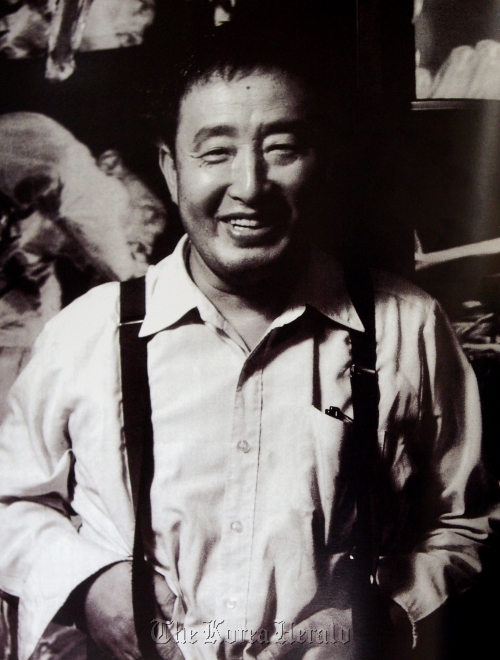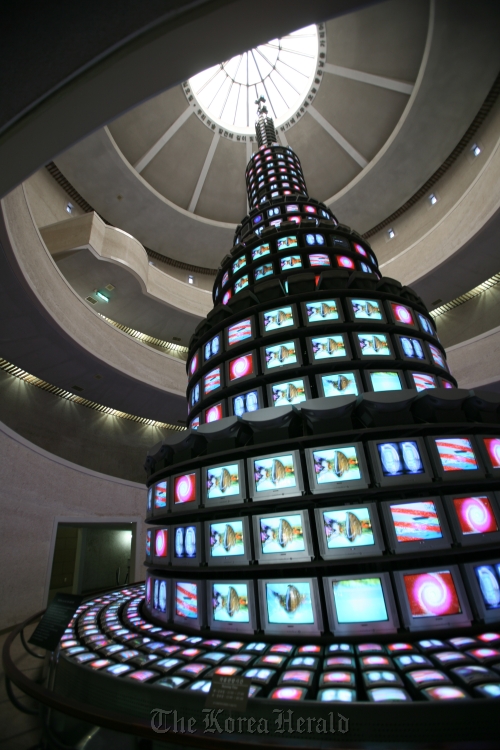Concerns mount even as memorial services and exhibitions mark the fifth anniversary of Korean video artist’s death
There is probably only one memorial service in the world where the mourners can smash up an electronic guitar to honor the deceased: video artist Paik Nam-june’s.
Memorial services to commemorate the fifth anniversary of the renowned South Korean artist’s death were held at several places including Bongeunsa, a temple in Samseong-dong, southern Seoul, and Nam June Paik Art Center in Yongin, Gyeonggi Province, for about a week starting Jan. 29.
Eccentric shows which could not be seen in such events elsewhere were solemnly showcased at Paik’s: Guitarist Kim Se-hwang, a member of the rock band N.E.X.T., smashed his guitar into pieces after throwing a performance at the Buddhist-style memorial service held at Bongeunsa and a video clip in which Paik pulls down his pants in front of former U.S. President Bill Clinton during his visit to the White House in 1998 was screened at the Confucian-style ritual at the art center.
The shows, however, were not surprising if Paik’s style is taken into account. They would have most likely have been the same, if not more bold, if the artist could have thrown his own memorial service.
Paik (1932-2006) was the father of video art, a composer, a performer and an inventor who broke down cultural barriers. He created technology-oriented but musical, ironic and funny works and invented novel terms like “electronic highway,” in which he demonstrated his outstanding insight that predicted the possibility of rapid global communication when such technology was barely born.
There is probably only one memorial service in the world where the mourners can smash up an electronic guitar to honor the deceased: video artist Paik Nam-june’s.
Memorial services to commemorate the fifth anniversary of the renowned South Korean artist’s death were held at several places including Bongeunsa, a temple in Samseong-dong, southern Seoul, and Nam June Paik Art Center in Yongin, Gyeonggi Province, for about a week starting Jan. 29.
Eccentric shows which could not be seen in such events elsewhere were solemnly showcased at Paik’s: Guitarist Kim Se-hwang, a member of the rock band N.E.X.T., smashed his guitar into pieces after throwing a performance at the Buddhist-style memorial service held at Bongeunsa and a video clip in which Paik pulls down his pants in front of former U.S. President Bill Clinton during his visit to the White House in 1998 was screened at the Confucian-style ritual at the art center.
The shows, however, were not surprising if Paik’s style is taken into account. They would have most likely have been the same, if not more bold, if the artist could have thrown his own memorial service.
Paik (1932-2006) was the father of video art, a composer, a performer and an inventor who broke down cultural barriers. He created technology-oriented but musical, ironic and funny works and invented novel terms like “electronic highway,” in which he demonstrated his outstanding insight that predicted the possibility of rapid global communication when such technology was barely born.

Born in Seoul during the Japanese colonial period, he studied at the University of Tokyo and later at Ludwig-Maximilians-University of Munich. He actively worked all over the world and kept a close friendship with composers Karlheinz Stockhausen, John Cage, artist Joseph Beuys and cellist Charlotte Moorman. He was also affiliated with the 1960s anti-art movement called Fluxus.
Paik was featured as one of The Century’s 25 Most Influential artists along with Pablo Picasso by ART News, an influential U.S. art magazine, in 1999 and was also chosen as one of the Asian Heroes, among 12 in the Artists and Thinkers category, by Time magazine in 2006. He is, still, arguably the most internationally famous Korean-born artist.
Exhibitions remember Paik
At Gallery Art Link in Anguk-dong, central Seoul, visitors can check out the photos of Paik’s first-ever performance in Korea on July 20, 1990, in the backyard of Gallery Hyundai in Sagan-dong, central Seoul.
In the photos, Paik dances around dressed up like a “mudang,” or shaman, to throw a sort of exorcism accompanied by some piano-smashing moves, in remembrance of Beuys.
Choi Jae-young, a photographer who witnessed the show at the time and is holding the current exhibition, remembered how he was totally enthralled.
“I was so mesmerized by every single moment. So I used almost 10 rolls of film,” said Choi.
The exhibition runs through Feb. 13. For details about the exhibition, call (02) 738-0738 or visit www.artlink.co.kr.
Two other photo exhibitions, “Nam Jun Paik: Alive” by Lee Eun-joo and “Shigeko Kubota: Prayer for Husband” by Chang Soung-un are underway at the Hankuk Art Museum in Yongin, Gyeonggi Province. The two photographers captured Paik’s studio where he lived with his wife and fellow artist Kubota. Some videos and print works by the two artists will be on display as well. The exhibition runs through Feb. 28. For more information, call (031) 283-6418 or visit www.hartm.com.
Nam June Paik Art Center is currently holding the exhibition “Mr. Abe ― The Greatest Doctor For Me.” It features more than 30 video artworks and documents in which Paik and Japanese engineer Shuya Abe collaborated, such as “Video Synthesizer” and “Nixon TV.“ The exhibition runs through March 31. For more information, call (031) 201-8500 or visit www.njpartcenter.kr.

Paik’s works undervalued
While a variety of events and exhibitions commemorate the artist, art insiders are also voicing concerns that Paik’s works are undervalued in the art market although he is very highly positioned in the world’s art history.
The highest auction price Paik’s work has ever fetched after he died was that of “Wright Brothers,” which sold at about HK $5,024,000 ($645,282) at Christie’s auction held in Hong Kong in 2007. Though the price was nearly double its low estimated price, it was not that high compared to those of other Asian countries’ top artists. The price of Paik’s works have only been dropping ever since.
“I remember that a couple of Paik’s spectacular works were auctioned off at Christie’s in 2009, at a relatively poor price compared to what many had expected. The size was too big for individual collectors. Since then, Paik’s works have not appeared in auctions much,” said Chey Yoon-seok, Fine Art General Sales Team Leader at Seoul Auction.
Chey said that it is due to the character of the artwork and local collectors’ lack of responsibility.
“First, Paik’s works are not very collectable. People prefer paintings or small-sized works that fit into their homes but Paik’s aren’t like that. The use of Braun-tube televisions also makes it hard for collectors to maintain and repair the works. The biggest problem, however, is local collectors. Foreign collectors will not look at Korean artworks unless local collectors first create a good supporting base by elevating the value.”
Art insiders have also long wished for government-run institutions that can run exhibitions and conservations of Paik’s works and hold seminars and workshops to shed light on the artist.
Nam June Paik Art Center, a Gyeonggi Cultural Foundation-affiliated art institution which opened in 2008, is so far the only museum of the kind. It runs permanent and special exhibitions and conducts researches.
The museum had a plan to open a Nam Jun Paik Research Center inside the art center that can focus more on studying and introducing Paik’s historical values to the public. The plan, however, was fizzled out due to budget issues.
“The art center still puts research first. We will continue to publish books and come up with different ways that can help collectors maintain and repair Paik’s works, like replacing the Braun-tube televisions with LCD monitors,” said Lee Chae-young, a researcher at the art center.
By Park Min-young (claire@heraldcorp.com)







![[KH Explains] How should Korea adjust its trade defenses against Chinese EVs?](http://res.heraldm.com/phpwas/restmb_idxmake.php?idx=644&simg=/content/image/2024/04/15/20240415050562_0.jpg&u=20240415144419)











![[Today’s K-pop] Stray Kids to return soon: report](http://res.heraldm.com/phpwas/restmb_idxmake.php?idx=642&simg=/content/image/2024/04/16/20240416050713_0.jpg&u=)